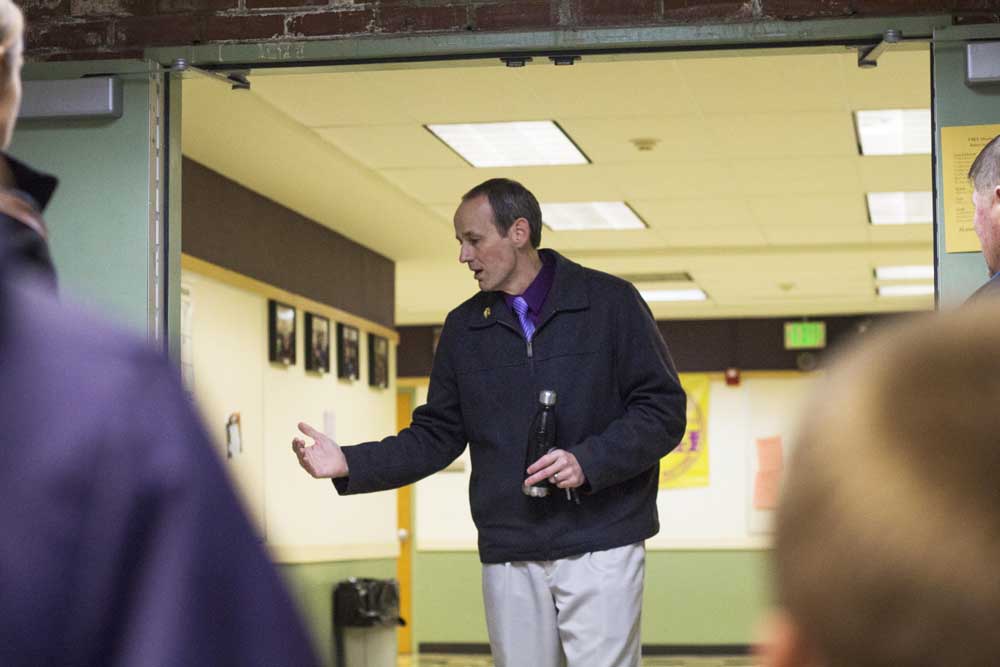Astoria schools ponder bond to improve buildings
Published 3:26 am Friday, March 9, 2018

- Lynn Jackson, principal of Astoria High School, said the campus needs modernization and increased security.
The Astoria School District has identified more than $77 million in long-term facilities needs, with a modernization of Astoria Middle School the highest priority.
The school district has been studying its options and gathering public input before the Astoria School Board decides this spring whether to float a bond for some of the improvements.
Astoria’s exploration of a bond measure comes as Warrenton-Hammond School District gauges public reaction to a proposed $32.4 million bond to buy a new master campus and construct a middle school, part of a longer-term plan to relocate schools out of the tsunami inundation zone. Seaside School District recently passed a $100 million bond to build a new kindergarten-through-12th grade campus on higher ground.
Submitting the long-range plan this month qualified Astoria for a $4 million matching grant from the state, should voters pass a bond.
Craig Hoppes, the Astoria superintendent, stressed that the ideas in the plan are preliminary and might not be the ultimate direction. Whatever the school district decides, a primary focus will be on safety and security, he said.
Since last year, the district has convened a facilities committee comprised of district staff and community members looking at facilities needs. This week, the district held tours of its buildings and a public meeting at the middle school to gather feedback.
“Like Warrenton, we’re surveying,” Hoppes said. “That starts next week. We’re going to find out what this community will pay for.”
Voters in Astoria last approved a $21.4 million school bond in 2000 for the construction of Lewis and Clark Elementary School; a new science center, gym and student commons at Astoria High School; renovation of the middle school’s track; and other improvements. The costs have decreased from the original $2.50 per $1,000 of assessed property value to $1.83 as of this year because of increased property values and bond refinancing. The expense comes off the tax rolls in two years.
Constructed in 1968, Astoria Middle School was touched least by the 2000 bond measure, aside from renovations to the track. It was built on a filled-in ravine. Although structurally sound, the campus has experienced numerous cracks in the floor and walls from settling.
“The floor, the concrete slab, isn’t connected to the foundation,” said Tom Bates, an architect advising the school district. “A lot of these cracks are related to the fact that there’s just been a lot of movement over years, because things aren’t knitted together the way we would do it in today’s construction versus back in ’68.”
Some of the classrooms at the middle school are undersized and have no windows or natural light, along with poor ventilation and antiquated infrastructure, Principal Linda Berger said.
The long-range facilities plan included a $31 million partial reconstruction and remodel of the middle school, creating three modernized small learning communities each able to accommodate up to 150 students.
Astoria High School, constructed in 1957, includes four separate buildings connected by covered walkways. The 2000 bond measure added a science center, student commons and auxiliary gym.
When the district recently locked front doors and added video intercom and buzz-in systems, the high school was not included because the dispersed campus includes more than 70 entry points.
“These doors are locked throughout the school day, but still … we do not have the ability to have a universal system of security,” said Lynn Jackson, the school’s principal. “One of the things we’re exploring are ways in which we can make these four buildings one and connected so that once our students arrive at 8 o’clock in the morning, they can navigate anywhere within the building, the campus, without having to leave.”
The school district is also hoping to modernize its shop spaces to accommodate new career-technical education programs, enlarge and modernize its science labs, add performing arts rehearsal spaces and remodel the auditorium, while fixing foundational issues in the locker rooms. The district also hopes to improve the tracks at the middle and high schools.
The long-range facility plan included $17 million worth of improvements needed at the high school.
John Jacob Astor Elementary School, the district’s oldest, was built in the 1920s, with an auxiliary gym added in 1935 and a newer main gym in the 1950s. The kindergarten-through-second grade school was remodeled and seismically upgraded through the 2000 bond measure.
Astor faces unique security issues as the school where the Arnold Schwarzenegger movie “Kindergarten Cop” was filmed. People regularly approach the school for tours, said Principal Kate Gohr. The house made famous in “The Goonies” movie is in the same Uppertown neighborhood.
“For ‘The Goonies’ (30th) anniversary, I had to hire a guard for my front door,” she said.
The main office is down the hall from the main entrance, an uncommon arrangement in modern schools. The district is looking at relocating it into part of the library nearer to the front door.
The district hopes to renovate the old gym into a multipurpose room and cafeteria, remodel several kindergarten classrooms, add more bathrooms and improve access for people with disabilities. The long-range plan included $5.8 million in improvements at the school.
“This is the one building where we’re worried about capacity,” Hoppes said.
The school district’s population has declined slightly in recent years, but Hoppes said it added about 75 students this year, largely in kindergarten. The projects at Astor would increase the school’s capacity by about 90 students.
The district’s long-range plan has also identified about $750,000 in improvements needed at Capt. Robert Gray School, used as the district’s main office, an alternative high school campus and for Head Start and district-run preschool programs. Another $250,000 was identified at Lewis and Clark, the district’s newest school.
The Astoria School Board will likely decide in May how to approach funding the improvements.




